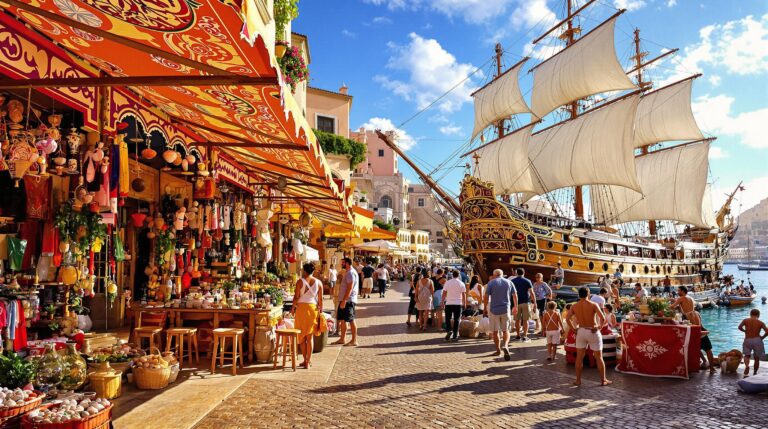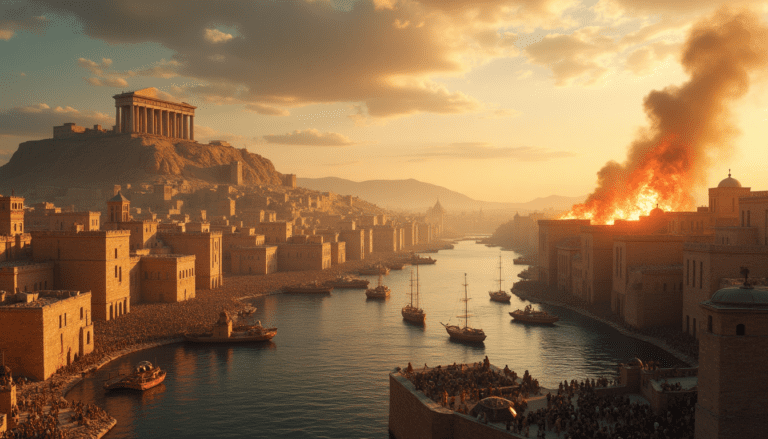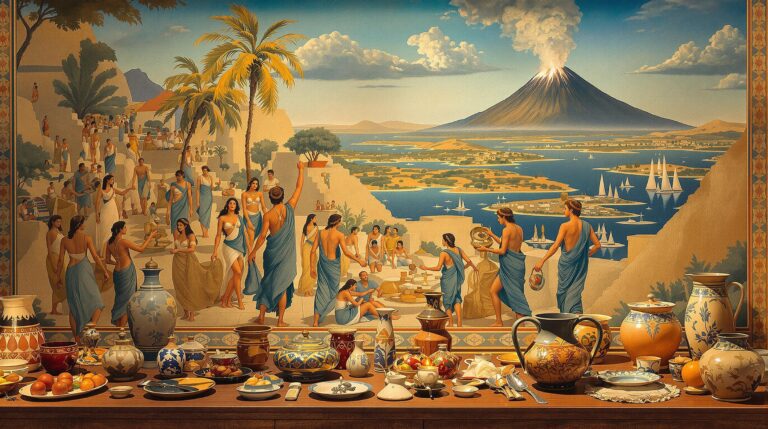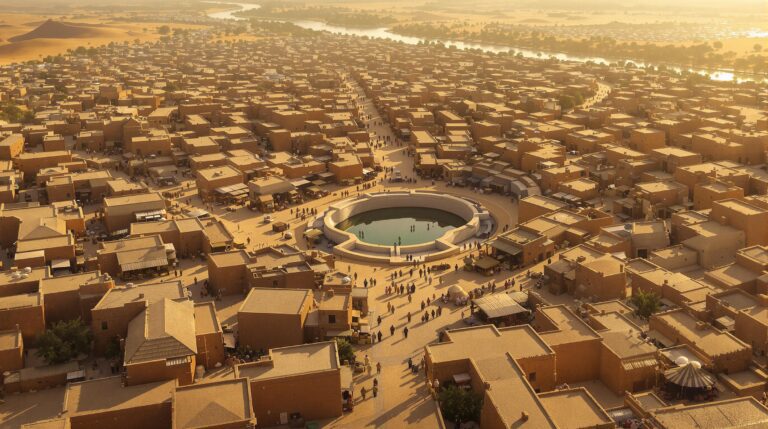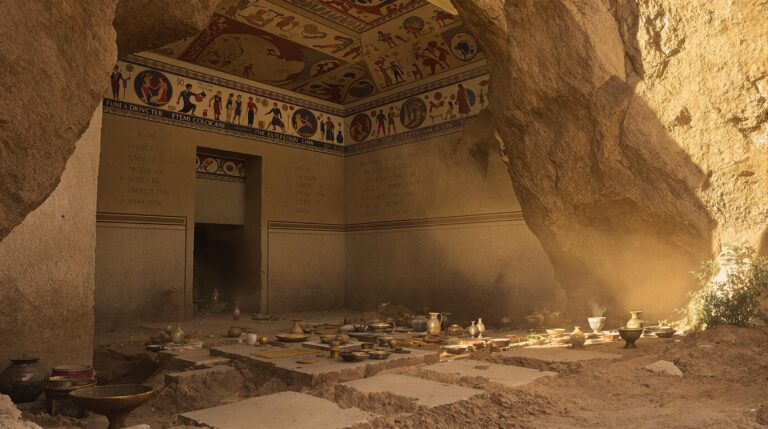Khmer Empire: The Builders of Angkor
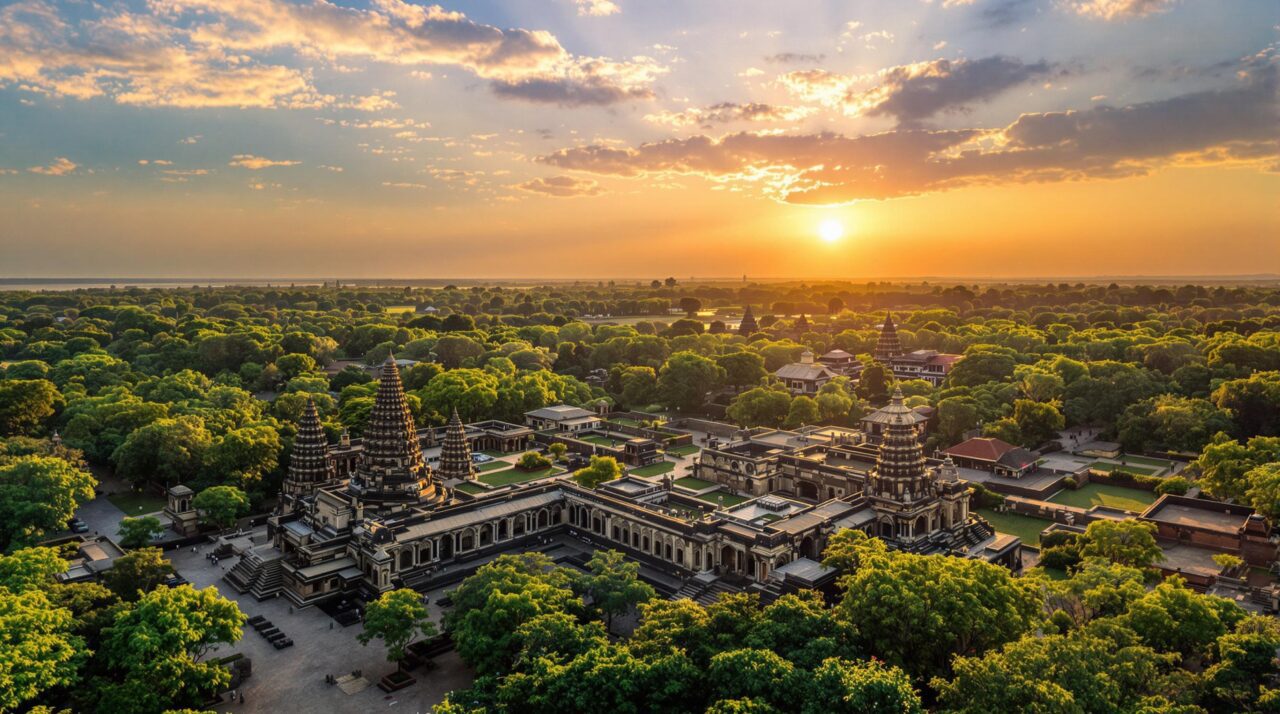
The Khmer Empire stands as a demonstration of human ingenuity, particularly in its creation of Angkor.
This vast city showcases remarkable urban planning and engineering, reflecting a society that harmonized with its environment.
The intricate water management systems and stunning temples hint at a deeper cultural narrative.
one explores the empire’s origins and its eventual decline, questions arise about the factors that led to its remarkable achievements and ultimate fate.
Principal Conclusions
Hide- The Khmer Empire, evolving from the Chenla Kingdom, established Angkor as its majestic capital through strategic military campaigns and cultural exchanges.
- Angkor's urban planning and architectural innovation showcased advanced engineering and water management, supporting agricultural productivity.
- The Bayon Temple's enigmatic faces and intricate bas-reliefs highlight the cultural and spiritual identity of the Khmer people.
- The shift from Hinduism to Buddhism in Angkor fostered a unique synthesis of religious motifs, influencing art and spiritual practices.
- Angkor Wat stands as a symbol of national identity and cultural heritage, emphasizing the importance of conservation and sustainable practices today.
The Origins and Expansion of the Khmer Empire
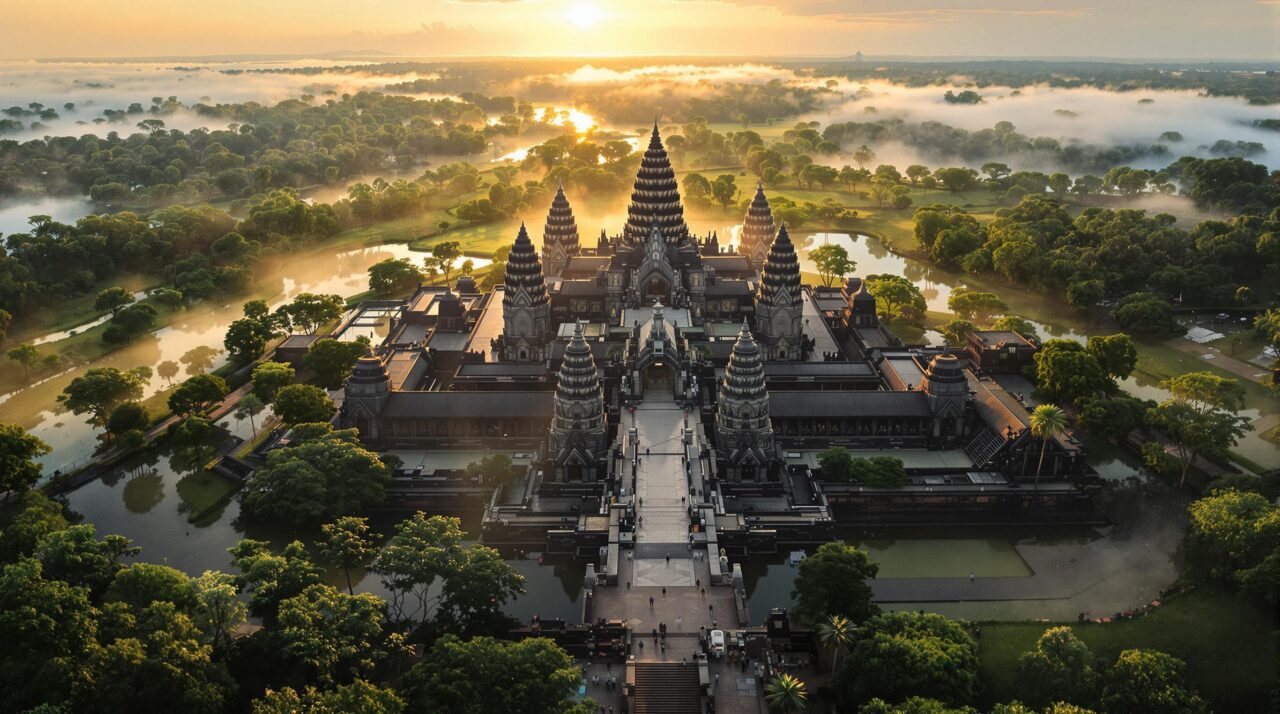
The Khmer Empire‘s origins can be traced back to the earlier Chenla Kingdom, where political and cultural foundations began to take shape.
Through a series of strategic military campaigns, the Khmer expanded their territory, solidifying their influence across Southeast Asia.
This transformation not only marked the rise of a powerful empire but also set the stage for the architectural marvels that would define Angkor.
From Chenla to Khmer: Foundations of Power
The shift from Chenla to the Khmer Empire marked a pivotal moment in the political landscape of mainland Southeast Asia.
Under the leadership of Jayavarman II, the declaration of independence not only reshaped regional dynamics but also established a nascent identity for the Khmer people.
This foundation of power initiated a complex interplay of cultural and political elements that would ultimately shape the empire’s trajectory.
Early political shifts in mainland Southeast Asia
As political dynamics shifted across mainland Southeast Asia, the rise of the Khmer Empire marked a pivotal transformation in regional power structures.
Emerging from the fragmented state of Chenla, the Khmer consolidated authority through strategic alliances and territorial expansion.
This reconfiguration of power not only challenged neighboring states but also initiated cultural exchanges that would shape the socio-political landscape for centuries to come.
Jayavarman II and the declaration of independence
Independence marked a defining moment in the history of the Khmer Empire, as Jayavarman II emerged as a formidable leader who sought to unite and elevate the fragmented territories of Chenla.
His declaration of independence not only challenged external influences but also sparked a sense of national identity.
This pivotal act laid the foundation for an expansive empire, fostering cultural and political cohesion among diverse communities.
Military Campaigns and Territorial Reach
The Khmer Empire’s military campaigns considerably shaped its territorial reach, extending across present-day Cambodia, Thailand, Laos, and Vietnam.
This expansion was not merely a matter of conquest; it necessitated a sophisticated administrative system, with regional governors overseeing the diverse lands and populations.
Understanding this duality of military might and governance provides insight into the resilience and adaptability of the Khmer Empire.
Conquests across present-day Cambodia, Thailand, Laos, and Vietnam
Conquering vast territories across Southeast Asia, the Khmer Empire established itself as a formidable power from the 9th to the 15th centuries.
Its military endeavors reshaped regional dynamics, leading to:
- The annexation of territories in present-day Thailand and Laos
- Strategic dominance over trade routes
- Cultural assimilation across diverse populations
These conquests fostered a rich cultural exchange and enhanced the Empire’s influence.
Administration of vast lands through regional governors
Following the successful military campaigns that expanded its territory, the Khmer Empire faced the challenge of effectively governing its vast and diverse lands.
To address this, the empire appointed regional governors, who balanced local autonomy with central authority. This administrative strategy not only facilitated efficient resource management but also fostered loyalty among the populace, essential for maintaining stability in a rapidly expanding domain.
Angkor: The Majestic Capital
Angkor, the heart of the Khmer Empire, exemplifies an extraordinary synthesis of urban planning and architectural innovation.
The strategic design of its city layout and extensive reservoir systems not only reflects advanced engineering practices but also highlights the civilization’s profound connection to water management.
Beyond the iconic Angkor Wat, a myriad of architectural masterpieces emerged, each contributing to the vibrant mosaic of cultural and religious expression that defined this majestic capital.
Planning the City and Its Reservoirs
The planning of Angkor’s cityscape reveals a sophisticated understanding of water management through the construction of barays and canals.
This intricate system not only facilitated agricultural productivity but also reflected the symbolic geography that underscored the Khmer Empire’s cosmological beliefs.
Barays, canals, and the mastery of water control
Masterful engineering characterized the Khmer Empire’s approach to water management, which was pivotal in shaping the sprawling urban landscape of Angkor.
The intricate network of barays and canals served multiple purposes:
- Regulation of irrigation for agricultural sustainability
- Flood control to protect urban areas
- Enhancement of trade routes through navigable waterways
This sophisticated system exemplified the empire’s deep understanding of their environment, showcasing their ingenuity and foresight.
Urban organization and symbolic geography
While the grandeur of Angkor is often celebrated for its monumental architecture, its urban organization reveals a deliberate and intricate planning strategy that reflects both functionality and symbolic significance.
The layout of temples, residential areas, and waterways illustrates a harmonious relationship between the natural and built environments, embodying the Khmer worldview and enhancing the spiritual experience of its inhabitants and visitors alike.
Architectural Masterpieces Beyond Angkor Wat
Beyond the iconic Angkor Wat, the Khmer Empire’s architectural legacy is vividly showcased in remarkable structures like the Bayon Temple, where its enigmatic faces provoke contemplation on identity and spirituality.
The interplay of nature and architecture is epitomized at Ta Prohm, where the jungle’s encroachment transforms stone into a living narrative of decay and resilience.
Meanwhile, the exquisite craftsmanship of Banteay Srei, with its delicate pink sandstone carvings, invites reflection on the artistic sophistication that flourished during this era.
Bayon Temple and its enigmatic faces
Among the architectural wonders of the Khmer Empire, the Bayon Temple stands out for its enchanting blend of artistry and spirituality.
Its enigmatic faces evoke curiosity and contemplation, inviting interpretations of identity and divinity.
Key features include:
- Intricate bas-reliefs depicting historical events
- Multiple serene faces thought to represent Avalokiteshvara
- Unique architectural layout symbolizing the cosmos
This temple embodies the rich cultural tapestry of its time.
Ta Prohm and the jungle’s embrace of stone
As nature intertwines with human achievement, Ta Prohm emerges as a striking tribute to the Khmer Empire‘s architectural ingenuity and its harmonious relationship with the surrounding jungle.
The temple’s ruins, enveloped by ancient trees, symbolize the delicate balance between civilization and the wild.
This enchanting fusion invites contemplation on humanity’s transient impact on nature and the enduring beauty of artistry amid relentless growth.
Banteay Srei and the artistry of pink sandstone
The intricate beauty of Banteay Srei stands in stark contrast to the grandeur of the Angkor complex, showcasing a different facet of Khmer artistry through its unique use of pink sandstone.
This temple exemplifies:
- Exceptional craftsmanship in intricate carvings
- Symbolic representation of Hindu mythology
- A harmonious blend of architecture and nature
Banteay Srei invites contemplation on the depths of cultural expression within the Khmer Empire.
Engineering, Art, and Religious Fusion
The Khmer Empire’s architectural achievements reflect a profound integration of engineering ingenuity and artistic expression, particularly evident in their stone constructions and intricate reliefs.
As the religious landscape shifted from Hinduism to Buddhism, these artistic elements adapted, showcasing a dynamic dialogue between faith and creativity.
This fusion not only defined the physical landscape of Angkor but also encapsulated the spiritual and cultural evolution of the Khmer people.
Stone Construction and Detailed Reliefs
The Khmer Empire’s monumental stone constructions, primarily utilizing sandstone blocks, reveal advanced engineering techniques that blended functionality with artistic vision.
These structures are adorned with intricate reliefs that narrate stories of battles, mythology, and courtly life, reflecting the cultural and religious ethos of the time.
This fusion of engineering and art not only served a decorative purpose but also reinforced the ideological narratives central to Khmer identity.
Construction methods using sandstone blocks
While exploring the construction methods of the Khmer Empire, one cannot overlook the significance of sandstone blocks, which served as the primary material for the grand edifices of Angkor.
Their use exemplified a harmonious blend of engineering and artistry, characterized by:
- Precise stone cutting techniques
- Intricate interlocking designs
- Advanced transportation methods
These elements collectively underscore the empire’s innovative spirit and reverence for religious expression.
Iconography depicting battles, mythology, and court life
Iconography within the Khmer Empire’s architectural masterpieces serves as a profound narrative tapestry, vividly illustrating battles, mythology, and court life.
These intricate reliefs not only reflect the empire’s historical and cultural values but also serve as a lens into the spiritual beliefs and societal structures of the time.
Such artistic expressions invite viewers to ponder the interplay between power, divinity, and daily existence.
The Shift from Hinduism to Buddhism
The shift from Hinduism to Buddhism within the Khmer Empire epitomizes a significant cultural evolution, reflected in the architectural and artistic landscape of Angkor.
Initially dominated by temples dedicated to deities like Shiva and Vishnu, the empire later embraced Mahayana and Theravāda Buddhism, leading to a fusion of religious motifs and engineering techniques.
This transformation not only altered the spiritual focus of the Khmer people but also enriched their artistic expressions, creating a unique synthesis that continues to captivate scholars and enthusiasts alike.
Temples dedicated to Shiva and Vishnu
As the Khmer Empire expanded its influence across Southeast Asia, the construction of temples dedicated to deities such as Shiva and Vishnu became a hallmark of its architectural and artistic endeavors.
These temples reflect a synthesis of engineering, artistry, and religious devotion:
- Intricate carvings showcasing mythological narratives
- Grand structural designs symbolizing cosmic order
- Ritual spaces fostering communal worship and spirituality
Such constructions illustrate the empire’s profound cultural legacy.
Later embrace of Mahayana and Theravāda Buddhism
While the Khmer Empire initially flourished under the auspices of Hinduism, a significant transformation occurred as the influence of Mahayana and Theravāda Buddhism gradually took root.
This shift not only redefined spiritual practices but also inspired architectural innovations and art forms, blending Hindu motifs with Buddhist themes.
Such synthesis reflected a dynamic cultural evolution, fostering a more inclusive religious landscape that resonated with diverse spiritual aspirations.
Governance, Society, and Daily Life
In the Khmer Empire, the king was not merely a ruler but revered as a divine figure, embodying the concept of the God-King or Devaraja, which profoundly influenced governance and societal structure.
This theocratic model shaped the dynamics of labor and agricultural practices, fostering innovations that supported the empire’s vast population.
Understanding these elements reveals the intricate relationship between authority, daily life, and the sustainability of the civilization.
The King as God-King (Devaraja)
In the Khmer Empire, the concept of the King as God-King, or Devaraja, formed the cornerstone of governance, intertwining political authority with divine legitimacy.
This symbiotic relationship not only mandated extensive temple-building projects that served as both religious and political symbols but also positioned the king as a pivotal figure in ceremonial duties and religious institutions.
Such dynamics shaped societal expectations and reinforced the king’s role as a mediator between the divine and the earthly domains, profoundly influencing daily life within the empire.
Divine legitimacy and temple-building mandates
As the Khmer Empire flourished, the intertwining of divine legitimacy and political authority became evident through the king’s role as the God-King, or Devaraja.
This sacred status facilitated temple-building mandates that served to:
- Reinforce the king’s divine right to rule
- Unite society under a shared religious framework
- Promote economic and cultural prosperity through architectural endeavors
These elements solidified the king’s power and legacy.
Ceremonial duties and influence over religious institutions
Ceremonial duties played a pivotal role in the governance of the Khmer Empire, with the king’s influence over religious institutions serving as a cornerstone of his authority.
This intertwining of the sacred and the political not only reinforced the king’s status as a divine figure but also guaranteed social cohesion, as rituals fostered a collective identity, binding the populace to their monarch and the divine order.
Society, Labor, and Agricultural Innovation
In the Khmer Empire, the intricate relationship between society and agricultural innovation was exemplified by advanced rice cultivation techniques supported by sophisticated hydraulic engineering.
This agricultural prowess not only sustained the population but also enabled the organization of labor for monumental temple and infrastructure projects, reflecting a complex societal structure.
Such innovations underscored the importance of governance in mobilizing resources and labor, ultimately shaping the empire’s enduring legacy.
Rice cultivation supported by hydraulic engineering
Rice cultivation in the Khmer Empire was intricately linked to advanced hydraulic engineering, a cornerstone of their agricultural success.
This innovative approach enabled the empire to thrive through:
- Efficient irrigation systems that maximized water distribution
- Flood management strategies that protected crops
- Seasonal crop rotation practices that enhanced soil fertility
These methods not only guaranteed food security but also fostered a resilient society, demonstrating the interplay between engineering and agriculture.
Labor organization for temple and infrastructure projects
The Khmer Empire’s monumental achievements in temple and infrastructure construction were underpinned by a sophisticated labor organization system that exemplified their governance and societal structure.
This system effectively mobilized diverse groups, including skilled artisans and laborers, fostering collaboration and innovation.
Decline and Rediscovery
The decline of the Khmer Empire can be attributed to a complex interplay of environmental stress and political fragmentation, which undermined its once-thriving civilization.
As the empire diminished, Western encounters began to play a pivotal role in the rediscovery and preservation of its architectural marvels, sparking renewed interest in the legacy of Angkor.
This juxtaposition of decline and rediscovery invites a deeper examination of how the past informs contemporary understanding and appreciation of cultural heritage.
Environmental Stress and Political Fragmentation
The Khmer Empire’s decline can be traced to a confluence of environmental stressors, particularly the effects of climate shifts and the breakdown of intricate irrigation systems that once supported its agricultural base.
As these foundational elements faltered, power struggles intensified, exacerbated by external pressures from neighboring regions.
This combination of internal fragmentation and external threats ultimately set the stage for a complex process of rediscovery, as the remnants of the empire grappled with its legacy amidst changing circumstances.
Impact of climate shifts and failed irrigation systems
Although the Khmer Empire thrived for centuries through sophisticated agricultural practices and monumental architecture, its eventual decline can be attributed markedly to environmental stressors, particularly climate shifts and the failure of intricate irrigation systems.
These factors led to:
- Diminished agricultural yields
- Increased vulnerability to droughts
- Social unrest due to resource scarcity
Such challenges ultimately fragmented the political landscape, hastening the empire’s fall.
Power struggles and external pressures
As environmental stressors weakened the Khmer Empire, internal power struggles and external pressures further exacerbated its decline.
Rival factions emerged, vying for control amid diminishing resources, while neighboring states seized the opportunity to exploit the empire’s vulnerabilities.
This fragmentation not only undermined political unity but also stifled innovation, ultimately leading to a tragic erosion of the once-thriving civilization’s cultural and architectural legacy.
Western Encounters and Preservation Efforts
The 19th century marked a pivotal moment in the history of the Khmer Empire as French explorers unearthed the grandeur of Angkor, sparking a renewed interest in its architectural and cultural legacy.
This encounter, however, also brought to light significant conservation challenges, as the intricate interplay between restoration and preservation efforts highlighted the fragility of these ancient structures.
The subsequent initiatives, while aimed at safeguarding the site, raise questions about the implications of foreign intervention in the stewardship of a culturally rich heritage.
Rediscovery by French explorers in the 19th century
While the Khmer Empire had long faded into obscurity, it was the intrepid explorations of French archaeologists in the 19th century that ignited a renewed interest in its monumental legacy.
Their findings revealed:
- The grandeur of Angkor’s architecture
- The intricate artistry of Khmer sculptures
- The significance of ancient inscriptions
These discoveries not only captivated European imaginations but also initiated a global discourse on cultural heritage and preservation.
Conservation challenges and restoration initiatives
Although the rediscovery of the Khmer Empire’s architectural marvels sparked international fascination, it also revealed a complex web of conservation challenges that threatened the very essence of these historical sites.
Environmental degradation, urban encroachment, and inadequate funding hinder restoration efforts.
Innovative initiatives are emerging, emphasizing sustainable practices and community involvement, yet the struggle to balance preservation with modern development remains an ongoing challenge for these invaluable treasures.
Legacy and Modern Influence
The Khmer Empire‘s enduring legacy is intricately woven into Cambodia’s national identity and serves as a pivotal reference point in global heritage discussions.
The monumental achievements of Angkor not only symbolize historical grandeur but also offer critical insights into the dynamics of rise and decline that resonate in contemporary society.
Analyzing these elements invites reflection on how the past can inform present and future governance and cultural preservation efforts.
Angkor in National Identity and Global Heritage
Angkor Wat, prominently featured on the Cambodian flag, serves as a powerful emblem of national identity, intertwining the nation’s past with its aspirations for the future.
The involvement of UNESCO in the preservation of this UNESCO World Heritage site underscores its significance not only as a cultural treasure but also as a catalyst for tourism that fuels economic growth.
Consequently, the legacy of Angkor extends beyond its ancient stones, influencing modern Cambodian society while shaping global perceptions of heritage and identity.
Symbolism of Angkor Wat on the Cambodian flag
Emblazoned on the Cambodian flag, the image of Angkor Wat transcends mere architectural representation; it serves as a potent symbol of national pride and cultural heritage.
This emblematic presence encapsulates:
- The resilience of Cambodian identity through historical adversity.
- A representation of spiritual and artistic achievement.
- A unifying force, fostering national solidarity among diverse communities.
Such symbolism reinforces a profound connection to the nation’s rich legacy.
Role of UNESCO and tourism in cultural preservation
Recognized globally, the Khmer Empire’s architectural marvels, particularly Angkor Wat, have become focal points for cultural preservation efforts.
UNESCO’s involvement highlights the intersection of heritage and tourism, where global interest fuels local economies but also challenges authenticity.
As visitors converge, the balance between preservation and commercialization becomes pivotal, shaping national identity while invoking questions about cultural integrity and the true essence of heritage.
Lessons from the Khmer Empire’s Rise and Fall
The Khmer Empire’s rise and fall offers critical insights into urban sustainability and the importance of architectural heritage in shaping contemporary Southeast Asian design.
By examining the empire’s innovative urban planning and enduring structures, one can better understand how historical contexts inform modern practices.
This legacy not only highlights the necessity of maintaining cultural continuity but also underscores the challenges faced in adapting to contemporary needs.
Urban sustainability and historical continuity
Although the Khmer Empire flourished over a millennium ago, the principles of urban sustainability and historical continuity embedded in its rise and fall offer valuable insights for contemporary societies.
Key lessons include:
- The importance of water management in urban planning.
- Integration of natural landscapes with urban development.
- The need for adaptive governance to respond to environmental challenges.
These insights emphasize resilience and sustainability in modern urban contexts.
Architectural heritage in Southeast Asian design
While the architectural achievements of the Khmer Empire stand as monumental proofs to its ingenuity, their influence extends far beyond the ruins of Angkor, shaping the broader landscape of Southeast Asian design.
This legacy manifests in contemporary structures that reflect ancient principles of harmony and scale, illustrating a cultural dialogue that persists.
Therefore, the Khmer Empire’s vision continues to inspire modern architects in their pursuit of identity and sustainability.
Wrapping Up
The Khmer Empire’s architectural prowess and innovative water management not only shaped Angkor’s grandeur but also influenced subsequent civilizations.
For instance, the restoration efforts of Angkor Wat in the 20th century exemplify how ancient techniques can inform modern conservation practices.
This ongoing engagement with the past highlights the enduring relevance of the Khmer legacy, prompting contemporary societies to reflect on sustainable practices in urban planning and environmental stewardship, ultimately bridging the gap between historical achievements and modern challenges.

